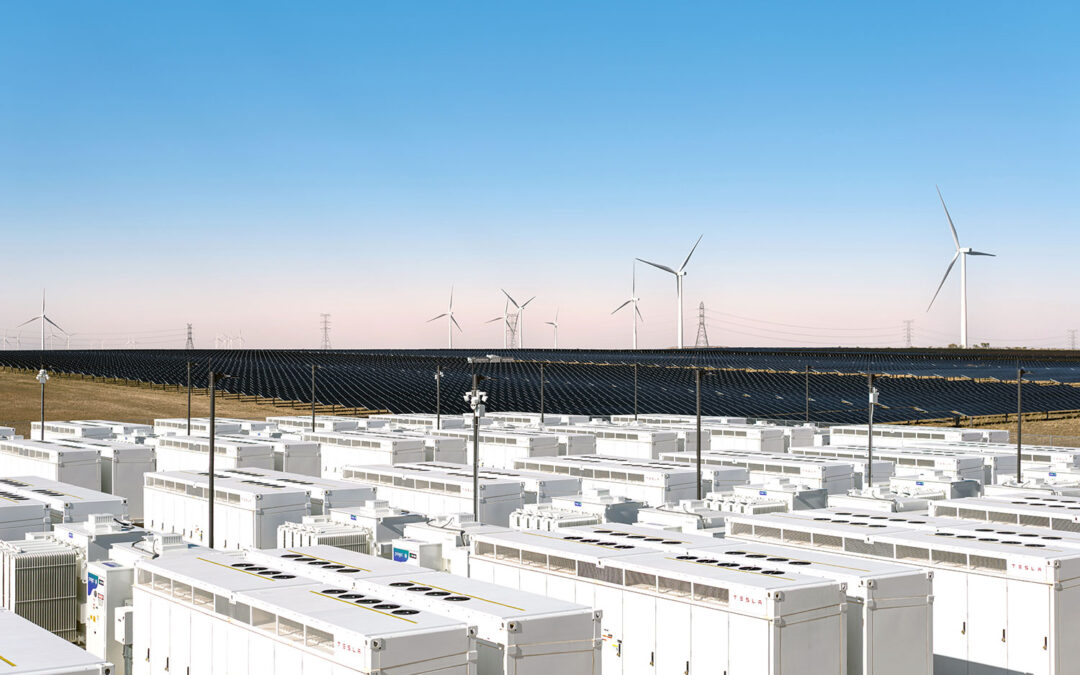By Sheldon Kimber, CEO and Founder, Intersect Power
For most of my career, I’ve been the most boring guy at San Francisco cocktail parties. I’ve never built a self-driving car or created a metaverse. I’m just the guy who runs a clean energy company and drives steel piles into the ground. Millions of steel piles. Over and over. How twentieth century of me! Well, it turns out that all those steel piles, foundations, and to be fair, increasingly complex power electronics, software, and energy storage systems, are one of the three critical inputs for the next generation of intelligence (chips, data… power). From steel piles to powering new forms of consciousness. Quite an upgrade in my social circle.
In all seriousness, what is happening today is a return to reality from “software is eating the world.” It is the realization that I wrote about in 2020 that perhaps some of that software is also a commodity that AI and other technologies might even create. All of it will require massive upgrades to the physical systems for power, communications, and compute.
The three concurrent megatrends of digitalization, electrification and decarbonization I wrote about last fall are reshaping demand for power and the systems that produce and deliver it. These megatrends demand power solutions that are fast to market, scalable, reliable, and affordable. Bonus points if they are also low carbon or can be decarbonized in the future.
The Power Grid Dilemma: Balancing New Demands and Existing Complexities
Between 2024 and 2040, electricity demand in the U.S. is expected to grow by 35-50%¹. The grid, which has historically delivered this power, is overwhelmed by a regulatory structure incapable of delivering on most of these needs and technical limitations from decades of underinvestment. Most regulators and policymakers are rightly more concerned with continuing to provide affordable, reliable power to current ratepayers than meeting the needs of these new loads. They want to ensure there is energy and capacity for current ratepayers and avoid having the costs of upgrades to serve these new loads fall on existing ratepayers who may not benefit.
The solutions proposed to date have been puzzling. We seem to have fallen prey to the old adage of “hear hoofbeats, think zebras,” and jumped to the most exotic solutions first. There seems to be enormous excitement around solutions involving new nuclear and large baseload gas plants, all delivered over the grid. Make no mistake, I believe we need both of these solutions to succeed in meeting the challenge of modernizing our power system, even without these new loads, but they are unlikely to meet the speed, reliability, and cost requirements of these new loads.
Hybrid Gas and Renewables: A Winning Combo
What, then, will American energy dominance look like? The global race for AI, advanced manufacturing, and decarbonization will be won in the most obvious and straightforward ways. Hybrid gas and renewables solutions will provide the speed, scale, reliability, and cost structure these new loads require. They’re quietly doing so right now, and they will continue to, simply because there is no other viable option. Our current projects are proof of this.
In many areas of the country, a combination of extremely cheap solar and wind can provide energy for 50-70% of the hours in a year. They can be easily paired with peaking gas generation that has lower up front capital cost than combined cycle gas turbine (CCGT) baseload, greater flexibility to ramp up and down, a more robust supply chain and modularity to provide greater reliability. Add in some battery storage to buffer load and help manage intermittency and the result is not your grandparents’ baseload power solution. It’s not a massive, central-scale nuclear, coal, or even CCGT baseload gas plant. It’s a modular, flexible, low-cost solution for tomorrow’s electricity demands.
This solution is available today with renewable and peaking gas supply chains capable of scaling, with many mature sites, interconnections in queues across the country, and capital markets prepared to finance such projects. Many of these solutions can be gigawatt-scale projects on a single site, making this by far the most scalable solution in the near term. What is less clear to mainstream observers is that this solution is also more reliable and less costly. Partisan politics has made it easy for people’s “aesthetics” and opinions to masquerade as values and facts, overriding basic math and engineering.
The reliability of a hybrid gas-peaker-and-renewables solution is more modular and can be engineered to provide far more redundancy than central-scale generation of almost any kind. When your solution is a collection of many mid and small size gas generators and renewable projects, the loss of a single gas turbine, inverter, wind turbine, or row of solar panels is far less impactful on overall reliability. In this case, the cost of having adequate backup to fill in for that potential contingency is far cheaper than central-scale plants.
Redundancy is a big reason why the solution is actually more economical overall, but it is not the only one. Renewables are the cheapest form of energy in our country today. Their Achilles heel is their intermittency or the fact that they can produce less in certain weather conditions. Combining renewables with less efficient gas peakers blends relatively expensive but very flexible on-demand generation with this inexpensive source of intermittent power. The result is a firm supply of electricity that can cover all hours of the year but in most hours uses the low-cost renewables giving us the most affordable baseload solution for tomorrow’s electricity needs.
Thinking Outside the Grid: A Way to Power Large Loads
The less obvious piece is how this new baseload solution will be delivered. As I have observed in numerous prior blogs, the grid is broken and no one seems particularly interested in fixing it. This is likely to drive these new loads in AI and advanced manufacturing to locations where renewable energy and gas are present in massive quantities, bonus points if future carbon sequestration capacity is nearby. This co-location may come with a grid interconnection for some amount of import or export, but not necessarily. We may see some of these new loads go completely off grid in new constellations or networks of load and co-located generation.
The degree to which this occurs will be dictated by the existing grid’s ability to meet the speed, scale, reliability, and cost targets of these new loads. Unfortunately, the speed is not governed by business or market forces, utility or non-utility. It is primarily dictated by overlapping layers of regulation and political frameworks with competing interests.
This impacts reliability. We are already seeing that these new loads, in addition to requiring a grid that is resilient to severe weather events and peak demand days, will also cause reliability issues for the grid itself. Virginia regulators recently disclosed an event that occurred last year where approximately 1.5GW of data center load dropped off the grid simultaneously, resulting in stability issues for the overall grid and all other customers requiring power². Luckily, the system held up, but this is the kind of near miss indicative of a physical system that will require significant upgrades to handle the integration of these new loads and a regulatory system lacking the political will and economic model to pay for such upgrades.
No More Waiting: We Must Start Building Today
We have often been promised a grid of tomorrow with easy interconnection for new loads and generation. This electricity super highway would tie together the new baseload solution articulated above, a lot of cheap renewables firmed by a combination of lots of flexible peaking gas generation and some battery storage. I’m hopeful that this will be our electricity system’s future, but I’m not paid to hope. I’m paid to build things, not wait around for someone else to solve my problems. Intersect is already in construction on one of the country’s largest co-located load and generation projects. More will follow shortly, including projects that integrate renewables and natural gas to provide the fastest, most scalable, most reliable, and most cost-effective solutions.
I want to be very, very clear on one important element here. None of the above is an attack on utility companies or their ability to provide electricity of the type and configuration I’ve outlined. Most of the utilities I know would love to invest in a flexible combination of gas and renewables. They’d love to create new cost allocation models and change the regulatory environment to accommodate tomorrow’s digital and manufacturing loads. Unfortunately, they are inextricably tied to decades of regulation that have made the energy delivery business model everything from a quasi-social safety net to a place to hide climate adaptation impacts such as wildfire and winterization costs. Utilities can do this. I’m not sure society will let them.
I am not trying to provoke yet another holy war over polarized aesthetics and narratives of how the world should be. Quite the opposite. I’m outlining a path forward where the success of gas and renewables is inextricably linked. A path where the incentives of new loads, non-utility generators, and the country’s largest utilities are aligned. A path where we get shit done again.
References

